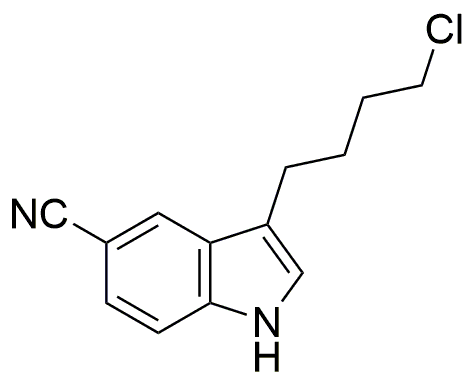3-(4-Chlorobutyl)indole-5-carbonitrile is widely utilized in research focused on:
- Pharmaceutical Development: This compound serves as a key intermediate in the synthesis of various pharmaceuticals, particularly in developing drugs targeting neurological disorders.
- Agricultural Chemicals: It is used in formulating agrochemicals, providing effective solutions for pest control while minimizing environmental impact.
- Material Science: The compound is explored for its potential in creating novel materials with unique electronic properties, beneficial for the development of advanced electronic devices.
- Biochemical Research: It acts as a valuable tool in studying biological pathways, aiding researchers in understanding cellular mechanisms and disease processes.
- Drug Discovery: The compound is involved in high-throughput screening processes, helping researchers identify promising drug candidates more efficiently compared to traditional methods.
General Information
Properties
Safety and Regulations
Applications
3-(4-Chlorobutyl)indole-5-carbonitrile is widely utilized in research focused on:
- Pharmaceutical Development: This compound serves as a key intermediate in the synthesis of various pharmaceuticals, particularly in developing drugs targeting neurological disorders.
- Agricultural Chemicals: It is used in formulating agrochemicals, providing effective solutions for pest control while minimizing environmental impact.
- Material Science: The compound is explored for its potential in creating novel materials with unique electronic properties, beneficial for the development of advanced electronic devices.
- Biochemical Research: It acts as a valuable tool in studying biological pathways, aiding researchers in understanding cellular mechanisms and disease processes.
- Drug Discovery: The compound is involved in high-throughput screening processes, helping researchers identify promising drug candidates more efficiently compared to traditional methods.
Documents
Safety Data Sheets (SDS)
The SDS provides comprehensive safety information on handling, storage, and disposal of the product.
Product Specification (PS)
The PS provides a comprehensive breakdown of the product’s properties, including chemical composition, physical state, purity, and storage requirements. It also details acceptable quality ranges and the product's intended applications.
Certificates of Analysis (COA)
Search for Certificates of Analysis (COA) by entering the products Lot Number. Lot and Batch Numbers can be found on a product’s label following the words ‘Lot’ or ‘Batch’.
Numéro de catalogue
Numéro de lot/série
Certificates Of Origin (COO)
This COO confirms the country where the product was manufactured, and also details the materials and components used in it and whether it is derived from natural, synthetic, or other specific sources. This certificate may be required for customs, trade, and regulatory compliance.
Numéro de catalogue
Numéro de lot/série
Safety Data Sheets (SDS)
The SDS provides comprehensive safety information on handling, storage, and disposal of the product.
DownloadProduct Specification (PS)
The PS provides a comprehensive breakdown of the product’s properties, including chemical composition, physical state, purity, and storage requirements. It also details acceptable quality ranges and the product's intended applications.
DownloadCertificates of Analysis (COA)
Search for Certificates of Analysis (COA) by entering the products Lot Number. Lot and Batch Numbers can be found on a product’s label following the words ‘Lot’ or ‘Batch’.
Numéro de catalogue
Numéro de lot/série
Certificates Of Origin (COO)
This COO confirms the country where the product was manufactured, and also details the materials and components used in it and whether it is derived from natural, synthetic, or other specific sources. This certificate may be required for customs, trade, and regulatory compliance.


